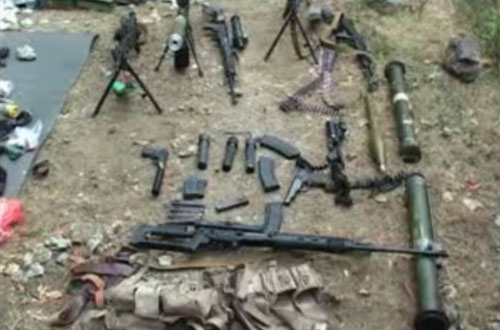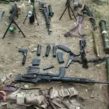
Georgian Forces in Shoot Out with North Caucasus Militants
Publication: Eurasia Daily Monitor Volume: 9 Issue: 162
By:

A Georgian news agency surprised everybody on August 28 with the announcement that the country’s armed forces had launched a special operation against an armed group near the Russian-Georgian border. It was presumed that the armed group had crossed from Russia into Georgia in the vicinity of the Lapota Gorge, which is near the Dagestani section of the Russian-Georgian border (www.apsny.ge/2012/mil/1346226678.php). According to initial news reports, the armed group took ten locals and tourists hostage (https://kavkasia.net/Georgia/2012/1346305681.php), but it turned out that only five young locals had been taken hostage. The armed group, consisted of approximately 17–20 militants, was spotted near the village of Lapankuri, located in Georgia’s Telavi district at the end of Lapota Gorge, bordering Dagestan’s Tsuntin district.
The Russians also were taken by complete surprise when they learned that the militants consisted of Georgians. The Russian side’s surprise was evident in the contradictory statements it made for several hours. At first Russian officials insisted that no group of militants had crossed from Russia into Georgia (www.ria.ru/world/20120829/733041145.html). A Federal Security Service (FSB) deputy spokesman Vadim Shibaev said “the information from the Georgian side about an incursion by an armed bandit group from Dagestan into Georgia is a provocation and has no real foundation.” However, by the evening of August 29, the Russians vaguely acknowledged that a group of militants had crossed the border in the area of Tsuntin district (www.ria.ru/terrorism/20120829/733024047.html#ixzz24wxdUSWI). At the end of August, this Dagestani district saw several brazen militant attacks on Russian outposts. The Russian side’s admission made it easier for the Georgians to speak of saboteurs sent from Russia having been defeated.
Meanwhile, insurgent websites stated that the slain people were insurgents but had no plans to attack sites in Georgia (https://vdagestan.com/?p=6577). The insurgent statements partially confirmed the Georgian version of events. It should be noted that there are no targets in that part of Georgia that could have attracted the rebels’ attention, so it is hardly justified to regard the armed group as saboteurs sent from Russia. Another source in the insurgency provided more details about the armed group, saying it was made up of new recruits who were forced to divert from their path along the Russian-Georgian border as they were heading toward the North Caucasus, and that is how they ended up inside Georgia. The source alleged that the group took no hostages but rather met a group of young people along the way and let them go. The militants reportedly asked the Georgian government forces to allow them to leave Georgia but the Georgians refused to let them go, after which the militants fought back, seeking to defend themselves (https://kavkazcenter.com/russ/content/2012/08/30/92774.shtml).
After such extensive information provided by the insurgents, there are few doubts the rebels were Russian citizens (www.golos-ameriki.ru/content/georgian-border-clashes/1498461.html) and that they came from Russia. Over the course of clashes between the rebels and Georgian forces inside Georgia between August 28–30, 11 insurgents were killed and six to nine managed to escape, while three Georgian servicemen were killed, including a military doctor, and five were wounded (https://newsgeorgia.ru/incidents/20120831/215184637.html). Against the backdrop of official Georgian statements, yet another version emerged on Internet social networks (www.golosislama.ru/news.php?id=11125): it alleged that the slain young militants were from Georgia’s Pankisi Gorge (www.golosislama.ru/news.php?id=11125) and were on their way to Syria via Dagestan. Deputy Georgian Interior Minister Shota Khizanishvili flatly denied this allegation (https://kavkasia.net/Georgia/2012/1346552859.php).
The militants were most likely heading to Dagestan to proceed on to Chechnya, as almost all the slain rebels who have been identified were ethnic Chechens. Two of them were from the Pankisi Gorge, while the rest were from Chechnya and Ingushetia but had most recently lived in Europe (www.apsny.ge/2012/mil/1346697680.php). As of September 4, there was no official reaction by the armed North Caucasus opposition, but their reaction to Georgia’s actions will likely be strong-worded.
Meanwhile, the Georgian leadership addressed the people of the North Caucasus, asking them not to allow Russia to use them in its games against Georgia. Moreover, the Georgian leaders offered to hold dignified funerals for the slain militants, according to their religious beliefs (www.apsny.ge/2012/pol/1346376670.php). This offer certainly contrasted with the way the corpses of militants are routinely treated by Russian forces in the North Caucasus (www.kadis.net/daily/?id=40566). While this gesture by the Georgian government will not go unnoticed by North Caucasus residents, the issues pertaining to Georgia’s relations with the Chechen and Dagestani societies remain. The dialogue is going to be difficult, but it must lead to a mutual understanding.
The Georgian authorities informed Russia about this incident, the biggest armed incident since the war in August 2008, via Switzerland, which represents Russia in Georgia. The Georgians also alerted all country members of NATO (https://ria.ru/terrorism/20120830/733592441.html), whose representatives expressed concern over the clashes. It should not be forgotten that this special operation by Georgian government forces was carried out on the eve of large Russian military exercises in the North Caucasus called Caucasus-2012. Therefore, any clashes in the border areas might have jeopardized bilateral relations, which have not been normalized since the August 2008 war.
In any case, the Georgian military has started mining paths that could possibly be used for future incursions from the Russian side of the border (https://newsru.com/world/30aug2012/miniruyut.html). The incident in turn will force the Georgians to approach the issue of guarding the state boundaries more seriously, especially along the Chechen and Dagestani sections of the border. Most likely, the OSCE and other Western institutions will be asked to monitor these areas as well.
With this special operation, Georgia sought to demonstrate its political maturity as a state, but it has evidently failed to identify its priorities in the North Caucasus. As a result of this incident Georgia discovered that it has no channels of communication—either directly or indirectly—with the Caucasus Emirate insurgents, and the armed clash along the border did nothing more than confirm this. Moscow has long alleged without ever presenting any hard evidence that Georgia has maintained contacts with the rebels fighting in the North Caucasus, and this tragic incident on the border confirms these allegations to be Russian fabrications. If there were such ties, then there would have never been any clash on the border with the militants in the first place. The border clash is unlikely to be the last incident in relations between Georgia and the North Caucasus. Georgia has much work to do to convince Chechens and Dagestanis that it is a brotherly country, especially in light of the recent struggle on the border.




